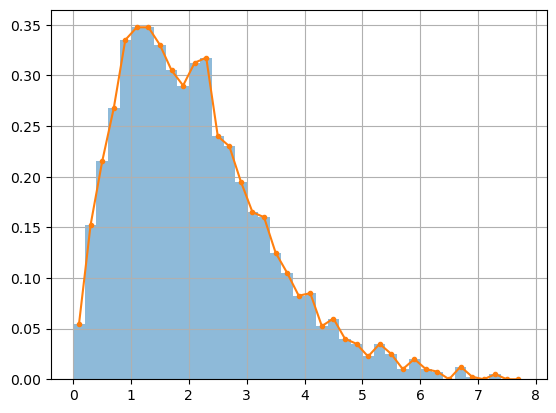Random Sampling#
import numpy as np
import matplotlib.pyplot as plt
from scipy import stats
SciPy Statistical Functions#
The NumPy subpackage numpy.random contains random number generators and all the usual distributions. The SciPy module scipy.stats is built on top of numpy.random and also includes several useful functions for working with probability distributions. Therefore we choose to use scipy.stats to generate random samples from probability distributions and to plot probability density functions.
Distribution Objects#
The module scipy.stats includes a Python object for each of the usual probability distributions. We can think of each object as representing an infinite family of distributions. Each distribution object includes a standard distribution and all other distributions in the family are determined by setting values of shape parameters (see loc and scale below).
scipy.stats.norm represents the family of normal distributions \(N(\mu,\sigma^2)\) and the standard density function is
scipy.stats.uniform represents the family of uniform distributions \(U(a,b)\) and the standard density function is
scipy.stats.expon represents the family of exponential distributions \(Exp(\lambda)\) and the standard density function is
scipy.stats.gamma represents the family of gamma distributions \(\Gamma(\alpha,\beta)\) and the standard density function with shape parameter \(\alpha\) is
where \(\Gamma(x)\) is the gamma function.
Density Function#
Each distribution object has a pdf function with the standard density function \(f(x)\) for the distribution and parameters loc and scale such that pdf is the corresponding density function:
As function transformations, the result is first scale by scale and then shift by loc.
Sampling Function#
Each distribution object includes a function rvs to generate random samples from the distribution. The name rvs refers to “random variables”. The parameters loc and scale determine the form the probability ditribution and the parameter N specifices the number of samples.
See also
Check out the documentation for scipy.stats.
Normal Distribution#
The object scipy.stats.norm is the Python object for the family of normal distribuitions \(N(\mu,\sigma^2)\). In this case, the parameter loc is the mean \(\mu\) and scale is the standard deviation \(\sigma\). Let’s use scipy.stats.norm.pdf to plot the density functions for different means and variances.
x = np.linspace(-5,10,100)
y0 = stats.norm.pdf(x,loc=0,scale=1)
y1 = stats.norm.pdf(x,loc=1,scale=2)
y2 = stats.norm.pdf(x,loc=2,scale=3)
plt.plot(x,y0,x,y1,x,y2)
plt.title('Normal Distribution $N(\mu,\sigma^2)$')
plt.legend(['$\mu=0,\sigma^2=1$','$\mu=1,\sigma^2=4$','$\mu=2,\sigma^2=9$'])
plt.grid(True)
plt.show()
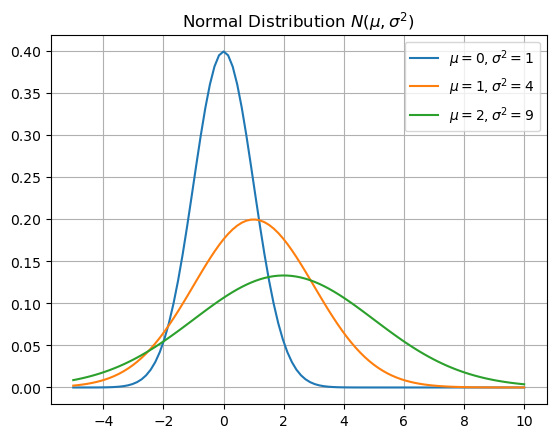
Let’s use the function scipy.stats.norm.rvs to generate random samples from the normal distribution \(N(\mu,\sigma^2)\), plot a histrogram of the samples and plot the corresonding probability density function.
N = 1000; mu = 1.; sigma = 0.5;
X = stats.norm.rvs(loc=mu,scale=sigma,size=N)
plt.hist(X,bins=50,density=True,alpha=0.5), plt.grid(True)
x = np.linspace(-1,3,100)
y = stats.norm.pdf(x,loc=mu,scale=sigma)
plt.plot(x,y)
plt.title('1000 Random Samples of N(1,1/4)')
plt.show()
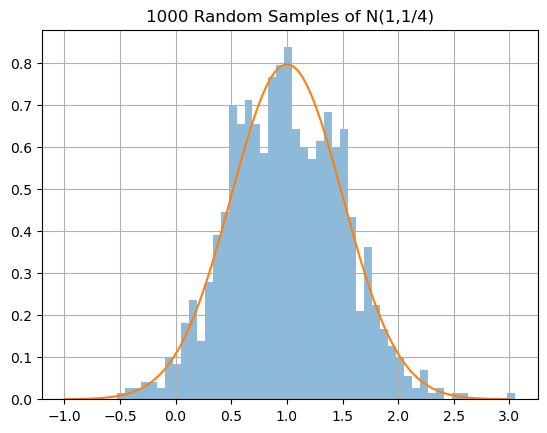
Uniform Distribution#
The object scipy.stats.uniform is the Python object for the family of uniform distribuitions \(U(a,b)\). In this case, the parameter loc corresponds to \(a\) and scale is \(b-a\). Let’s use scipy.stats.uniform.pdf to plot the density functions for different values \(a\) and \(b\).
x = np.linspace(-2,5,500)
y0 = stats.uniform.pdf(x,loc=0,scale=1)
y1 = stats.uniform.pdf(x,loc=1,scale=2)
y2 = stats.uniform.pdf(x,loc=-1,scale=5)
plt.plot(x,y0,x,y1,x,y2)
plt.title('Uniform Distribution U(a,b)')
plt.legend(['$a=0,b=1$','$a=1,b=3$','$a=-1,b=4$']), plt.grid(True)
plt.show()
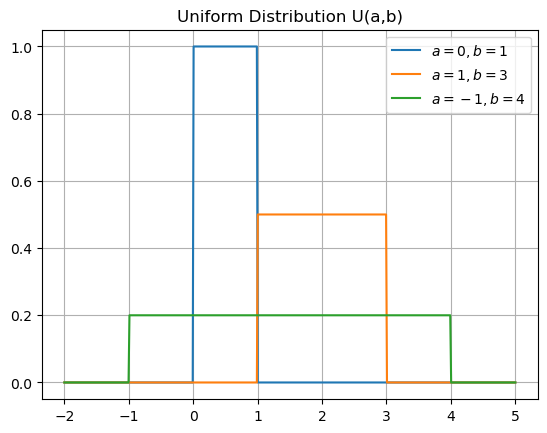
Let’s use the function scipy.stats.uniform.rvs to generate random samples from the normal distribution \(U(a,b)\), plot a histrogram of the samples and plot the corresonding probability density function.
N = 1000; a = -1.; b = 3;
X = stats.uniform.rvs(loc=a,scale=(b-a),size=N)
plt.hist(X,bins=20,density=True,alpha=0.5), plt.grid(True)
x = np.linspace(-2,4,200)
y = stats.uniform.pdf(x,loc=a,scale=(b-a))
plt.plot(x,y)
plt.ylim([-0.2,1.0]), plt.title('1000 Random Samples of $U(-1,3)$')
plt.show()
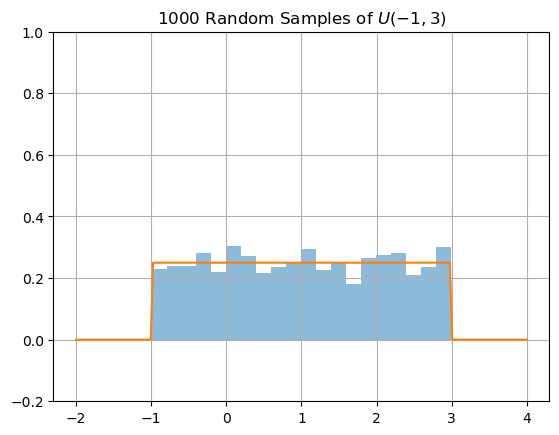
Exponential Distribution#
The object scipy.stats.expon is the Python object for the exponential distribution \(Exp(\lambda)\). In this case, the parameter scale corresponds to \(1/\lambda\). Let’s use scipy.stats.expon.pdf to plot the density functions for different values \(\lambda\).
x = np.linspace(-1,10,200)
y0 = stats.expon.pdf(x,loc=0,scale=1)
y1 = stats.expon.pdf(x,loc=0,scale=2)
y2 = stats.expon.pdf(x,loc=0,scale=3)
plt.plot(x,y0,x,y1,x,y2)
plt.title('Exponential Distribution $Exp(\lambda)$')
plt.legend(['$\lambda=1$','$\lambda=1/2$','$\lambda=1/3$']), plt.grid(True)
plt.show()
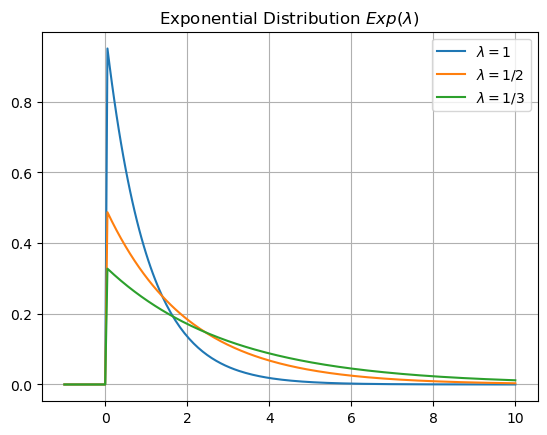
Let’s use the function scipy.stats.expon.rvs to generate random samples from the normal distribution \(Exp(\lambda)\), plot a histrogram of the samples and plot the corresonding probability density function.
N = 1000; lam = 0.2;
X = stats.expon.rvs(loc=0.,scale=1/lam,size=N)
plt.hist(X,bins=range(30),density=True,alpha=0.5), plt.grid(True)
x = np.linspace(-1,31,200)
y = stats.expon.pdf(x,loc=0.,scale=1/lam)
plt.plot(x,y)
plt.title('1000 Random Samples of Exp(0.2)')
plt.show()
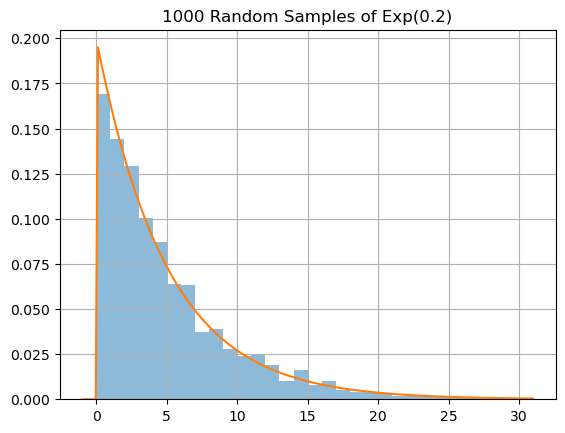
Gamma Distribution#
The object scipy.stats.gamma is the Python object for the gamma distribution \(\Gamma(\alpha,\beta)\). In this case, we must specify \(\alpha\) as a shape parameter and the parameter scale corresponds to \(1/\beta\). Let’s use scipy.stats.gamma.pdf to plot the density functions for different values \(\alpha\) and \(\beta\).
x = np.linspace(-1,8,200)
y0 = stats.gamma.pdf(x,1.75,loc=0,scale=1)
y1 = stats.gamma.pdf(x,2.5,loc=0,scale=1.5)
y2 = stats.gamma.pdf(x,3,loc=0,scale=0.8)
plt.plot(x,y0,x,y1,x,y2)
plt.title('Gamma Distribution $\Gamma(a,b)$')
plt.legend(['$a=7/4,b=1$','$a=5/2,b=2/3$','$a=3,b=5/4$']), plt.grid(True)
plt.show()
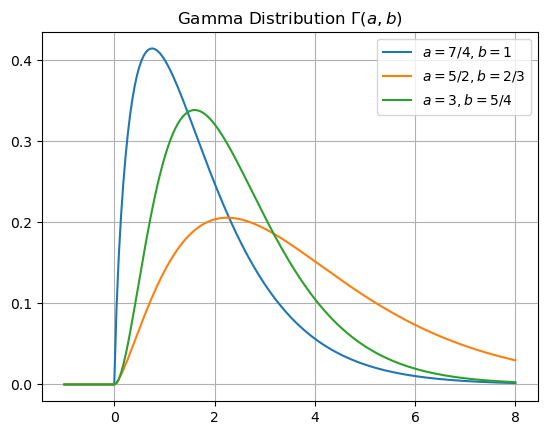
Let’s use the function scipy.stats.gamma.rvs to generate random samples from the normal distribution \(\Gamma(\alpha,\beta)\), plot a histrogram of the samples and plot the corresonding probability density function.
N = 1000; alpha = 5; beta = 2/3;
X = stats.gamma.rvs(alpha,loc=0.,scale=1/beta,size=N)
plt.hist(X,bins=np.arange(0,20,0.5),density=True,alpha=0.5), plt.grid(True)
x = np.linspace(-1,20,200)
y = stats.gamma.pdf(x,alpha,loc=0.,scale=1/beta)
plt.plot(x,y)
plt.title('1000 Random Samples of $\Gamma(5,2/3)$')
plt.show()
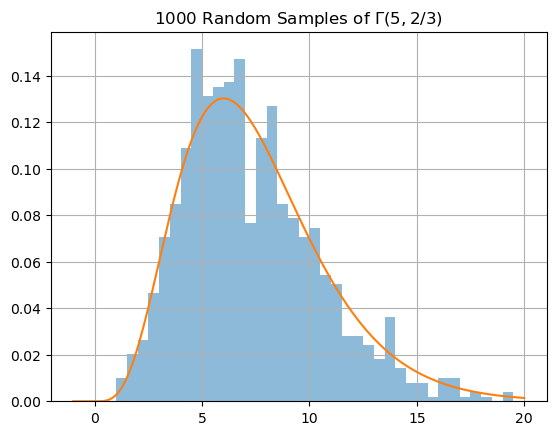
Functions of Random Variables#
Let \(X_1,\dots,X_n\) be (independent) continuous random variables and let \(g : \mathbb{R}^n \rightarrow \mathbb{R}\) be a function. Then \(Y = g(X_1,\dots,X_n)\) is also a random variable and we would like to find its probability density function \(f_Y(x)\). There is a closed form solution in the case that \(n=1\) and \(g\) is an invertible function however there is no explicit formula for \(f_Y\) in general. So what can we do? Generate random samples of \(X_1,\dots,X_n\), compute \(Y = g(X_1,\dots,X_n)\) for each sample and plot the distribution of values \(Y\). This generates an approximation of the \(f_Y\). In particular, the function plt.hist(Y,density=True) creates the histogram of the samples in Y and it also returns 3 values: array of relative frequency values, array of bin edges and the figure object. Compute the midpoint of each bin and plot the corresponding relative frequency to obtain an approximation of the density function. The result is not smooth and there are better methods for approximating the density function \(f_Y\) such as kernel density estimation which we will see in later sections.
For example, let’s apply this method to the standard normal distribution:
N = 1000
X = stats.norm.rvs(loc=1,scale=1,size=N)
freqs,bins,_ = plt.hist(X,bins=40,density=True,alpha=0.5)
mids = (bins[:-1] + bins[1:])/2
plt.plot(mids,freqs,'.-')
plt.grid(True)
plt.show()
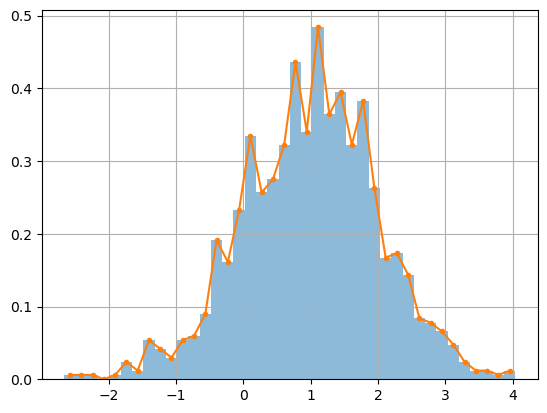
See also
Check out Wikipedia: Functions of Random Variables for more details.
Example: Sum of Normal Variables#
Let \(X_1 \sim N(\mu_1,\sigma^2_1)\) and \(X_2 \sim N(\mu_2,\sigma^2_2)\) be normal random variables and let \(Y = X_1 + X_2\). It can be shown that \(Y \sim N(\mu_1 + \mu_2,\sigma^2_1 + \sigma^2_2)\) however let’s compute random samples and plot the histogram.
N = 1000
X1 = stats.norm.rvs(loc=-1,scale=1,size=N)
X2 = stats.norm.rvs(loc=1,scale=2,size=N)
Y = X1 + X2
freqs,bins,_ = plt.hist(Y,bins=25,density=True,alpha=0.5)
mids = (bins[:-1] + bins[1:])/2
plt.plot(mids,freqs,'.-')
plt.grid(True)
plt.show()
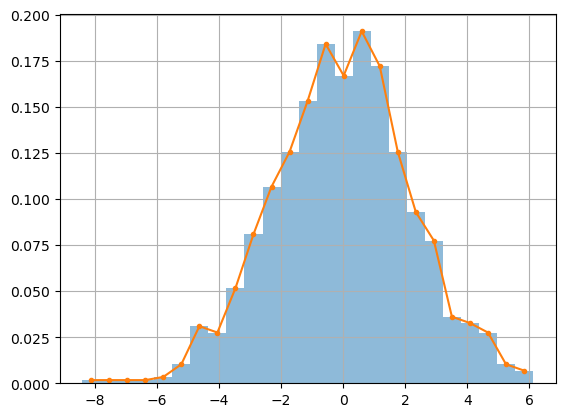
Example: Norm of Normal Variables#
Let \(X_1 \sim N(\mu_1,\sigma^2_1)\) and \(X_2 \sim N(\mu_2,\sigma^2_2)\) be normal random variables and let \(Y = \sqrt{X_1^2 + X_2^2}\). Then \(Y\) is given by the chi distribiution. Let’s compute random samples and plot the histogram.
N = 2000
X1 = stats.norm.rvs(loc=0,scale=1,size=N)
X2 = stats.norm.rvs(loc=1,scale=2,size=N)
Y = np.sqrt(X1**2 + X2**2)
freqs,bins,_ = plt.hist(Y,bins=np.arange(0,8,0.2),density=True,alpha=0.5)
mids = (bins[:-1] + bins[1:])/2
plt.plot(mids,freqs,'.-')
plt.grid(True)
plt.show()
